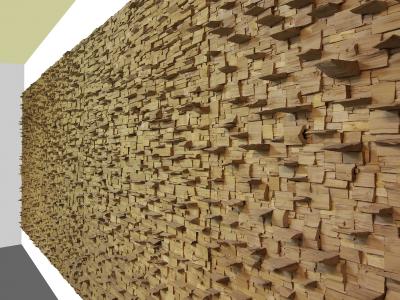Jan de Weryha-Wysoczański
Mediathek Sorted






































































































Other Polish sculptors deliberately turned away from "precious" materials and pursued non-representational tendencies. They regularly took part in symposia and exhibitions in Western countries. Jarnuszkiewicz developed expansive abstract sculptures from welded metal sheets. Magdalena Abakanowicz, who had actually studied painting, found new abstract forms in textile art by weaving a "rough" material, sisal, as used for ship ropes, into room-filling tapestries hanging freely from the ceiling, the "Abakans," for which she was awarded the Grand Prix at the 1965 Sao Paulo Biennale. The Polish academies also initiated a renewal of textile art. There they created three-dimensional wall reliefs and room-filling environments that occupied areas of sculpture. The surfaces of these abstract, freely designed works transferred the 'all-over' of Jackson Pollock's painting and European Informality into structures made of natural material. Similarly rough-structured reliefs can recently be found in de Weryha's work. These range all the way to the wall-filling format, where he dissolves the underlying geometric grids into an 'all-over' of fragments placed close to one another (ill. 37, 39, 42, 52, 80, 90).
Wood, which is widely known in Central Europe to have been used in figurative sculpture for well over a thousand years, only becomes a "base" or "poor" material when it finds its way into art as a find from nature or everyday life. In the early 1960s, leading artists of the Italian art movement 'Arte povera' began working with found materials from nature, but also with every conceivable material from everyday life. They showed that even "poor" materials can be charged with myths, stories, metaphors, and symbols, thereby opposing the traditional hierarchy of materials, mass consumption and even plain Minimal Art. From the very start Mario Merz worked with bundles of brushwood, which he arranged in groups along the wall, laid out on the ground, or from which he constructed his well-known "igloos". But he also used many other materials. Giuseppe Penone still uses tree trunks directly obtained from nature for his installations, the natural form of which remains visible even after extensive artistic interventions.
In de Weryha's work, the vertically and horizontally layered works, in which the wood is only roughly segmented to reveal its natural beauty and variety (ill. 3, 9, 17, 24), the ground works of branches and bark (ill. 54, 55, 65) and the "wooden object" of layered birch branches and veins (ill.57) have the closest connection to 'Arte povera'. It is hardly necessary to emphasize that de Weryha does not perceive wood as a "poor" material, but rather celebrates its richness in forms, colours and structures. Similar to the 'Arte povera' artists, who emphasized the high narrative and emotional value of the materials they used, he also points to their culturally critical, social aspect. He is keen that his work with wood, which plays an important role as a catalyst in the cycle of nature, "in a society that regrettably is only oriented towards consumption and above all profit, will at least make people stop and think for a short moment".[9]
In view of his circular and partly conically layered floor works of wood or bark segments (ill. 16, 22, 23, 25, 26, 29), past authors, who could not yet know the current range of de Weryha's works, referred to impulses from Land Art, above all from Richard Long and Robert Smithson.[10] Likewise at the end of the 1960s, American artists transferred colossal forms of Minimal Art to the deserts and mountains of North America. They marked traces of their wanderings, redesigned gorges, dunes, and watercourses with construction machines, and created stone settings in the form of circles and spirals. One of these was Smithson's "Spiral Jetty" (1970), which was reminiscent of prehistoric places of worship. These artists also set up an alternative to the industrial consumer world by working in and with nature, uncovering the history of the earth and exposing their works to renewed corrosion. But here lies the decisive difference to de Weryha: his works are basically conceived for interior spaces and only in a few cases (and then temporarily) are meant to take place outside (ill. 60, 61). Due to their size, however, some of his ground works could only be exhibited by moving them elsewhere. Two such examples were "Orońsko" 2006 (ill. 53) and "Chilehaus" 2011 (ill. 67). On the other hand, Richard Long has also conceived circular wall tableaus of meditative circles of stones, peat, driftwood, branches, firewood and river mud, for museums and exhibition spaces in order to make them accessible to a larger public. The connection between de Weryha and Land Art is not only formal, but above all a love of the world and nature.
[9] ibid
[10] Jan Stanisław Wojciechowski 2005, p. 5/9 (see further reading; text available online on the website of the artist, polish, page 2/english, page 2); Dorota Grubba 2006, p. 4112/4115 (see further reading; text available online on the website of the artist). Maryla Popowicz-Bereś referred in her 2014 master's thesis (see further reading) even Richard Long as the main source of inspiration for de Weryha, p. 43 (text available online on the website of the artis; german translation ibid, p. 39)





















































































